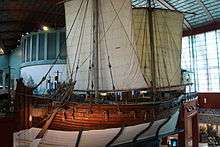Jewel of Muscat

The Jewel of Muscat is a ship based on the design of the Belitung shipwreck, an Arabian dhow that was found off the coast of Belitung Island, Indonesia, in 1998 and subsequently salvaged. It was built in a joint effort by the governments of Oman and Singapore and Mike Flecker, one of the people employed by the salvage company Seabed Explorations at the time of the original recovery.[1]
Background
Present-day knowledge of the original materials and methods used in construction of the Jewel and this type of Arab dhow stems largely from the shipwreck itself, found preserved under sediment. The sediment preserved the remains of the wooden vessel and without this the wreck would have been lost due to worms. Most important were the discoveries about the methods of construction which were repeated in the construction of the Jewel.
Fortunately pieces of the original timbers were preserved, allowing scientists to analyse the remains and determine the types of wood used. Timbers from a number of tree species were found, including one that is unique to central Africa. After analysing the hull form, timber species, and construction methods, archaeologists concluded that the wreck was of Indian or Arabian origin, utilising some imported wood.[2][3]
Construction and voyage
The Jewel was built at Qantab near Muscat, the capital of Oman.[4] Construction began in October 2008 and it set sail for Singapore on 16 February 2010, arriving on 3 July 2010.[5]
The ship is remarkable in that it was sewn together, following the construction techniques used in the wrecked ship, rather than the using more traditional methods of pegs or nails. The dhow is about 21 feet (6.4 m) wide and 58 feet (18 m) long. It is an accurate reproduction thanks to the measurements taken by Walterfang's team during the excavation.
Timber for the ship was made from Afzelia africana trees felled in Ghana and cut into planks and frames at a Ghanaian lumberyard.[5] Boards were trimmed and sanded. Trimmed boards were steamed individually in a fire-heated steambox to make them flexible. When workers removed a board from the box, they had two minutes to carry it to the ship and clamp it into place in a bent and slightly twisted shape before it would stiffen again.[6] It was then sewn into position using coir rope and caulking made from multiple strands of fine coir rope with a diameter of about 3 millimetres (0.12 in). In addition, the planks were coated with shark liver oil to make them water-resistant.[7]
The Jewel made one voyage, from its shipyard in Oman 5000 kilometers to its berth in Singapore, following an ancient trade route, in stages, via Galle in Sri Lanka. The captain was Saleh al Jabri, with 25 years of sailing experience.[4] Illustrations show that the ships were square-rigged, but the virtually nothing was known of their rigging. The sails were handmade from canvas. The main sail was 81 square metres and weighed over 150 kilograms. The second mast bore a smaller mizzen sail. "Mizzen" is an Arabic word that means balance. The mizzen sail is used, in part, to steer the ship. A crew of at least eight is needed to manage the sails.[4]
An ancient navigational tool called a kamal is used to make sightings of known stars compared to the horizon, measuring the ship's latitude.[4]
The ship became becalmed and the captain procured a tow from the Indian Coast Guard. They were towed to the city of Cochin in Kerala State, India. After a month at sea, the boat was befouled with algae and barnacles. It was taken to dry dock, scraped, and coated with chunam, a mixture of goat fat and lime.[4][8]
The ship proceeded from Cochin to Galle in Sri Lanka. There, the masts were replaced with fresh teak logs.
The Jewel of Muscat is housed in the Maritime Experiential Museum and Aquarium in the Sentosa resort in Singapore.[9]
See also
References
- ↑ "Jewel of Muscat". WoodenBoat (217): 80–83. November–December 2010.
- ↑ Flecker, Michael (1 August 2000). "A 9th-century Arab or Indian shipwreck in Indonesian waters". The International Journal of Nautical Archaeology. IJNA. 29 (2): 199–217. doi:10.1006/ijna.2000.0316.
- ↑ Geoff Wade (December 2003). "The Pre-Modern East Asian Maritime Realm: An Overview of European-Language Studies". Working Paper Series. Asia Research Institute, National University of Singapore. No. 16: 20.
- 1 2 3 4 5 National Geographic TV, Sailing the Treasure Ship. Viewed 2013-01-13.
- 1 2 "Timeline". Jewel of Muscat. Retrieved 26 January 2011.
- ↑ Jewel of Muscat Archive. Video clip, "Planking Process." Accessed 2013-01-13.
- ↑ National Geographic TV, Arab Treasure Ship. Viewed 2013-01-13.
- ↑ Vosmer, Tom. The Jewel of Moscat: Reconstructing a Ninth-Century Sewn-plank Boat, tenth page. Accessed 2013-01-13.
- ↑ "Maritime Xperiential Museum (Opening after 2010)". Retrieved 10 February 2011.
External links
- Official site
- Video – Captain Saleh Said Al Jabri's account of the crossing from Galle, Sri Lanka to Penang, Malaysia